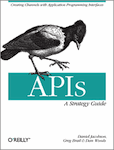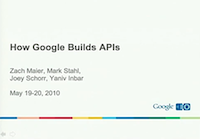Brandon Satrom has written a cool article on the secrets of awesome JavaScript API Design. While the focus is squarely on JavaScript, Brandon talks about the greater qualities of good API design and the need for developers to think about how other developers will use their code.
Latest Posts for 'Web APIs'
Government recommendations for Web API Design
|
| Monday, December 3rd, 2012 |
 The US Federal government has published a set of guidelines for government agencies that want to design Web-based APIs. This includes recommendations on authentication, keys, documentation, and code samples; with links to examples of Web APIs in the .gov domain.
The US Federal government has published a set of guidelines for government agencies that want to design Web-based APIs. This includes recommendations on authentication, keys, documentation, and code samples; with links to examples of Web APIs in the .gov domain.
Richardson Maturity Model
|
| Tuesday, April 24th, 2012 |
 Martin Fowler wrote about a way to approach RESTful Web APIs developed by Leonard Richardson. This presents 4 successive levels of concepts, from the simple “plain old XML” layer, through the notion of resources, http verbs, and hypermedia controls. Martin does a great job of explaining each of the layers through the use of figures and example XML data.
Martin Fowler wrote about a way to approach RESTful Web APIs developed by Leonard Richardson. This presents 4 successive levels of concepts, from the simple “plain old XML” layer, through the notion of resources, http verbs, and hypermedia controls. Martin does a great job of explaining each of the layers through the use of figures and example XML data.
New eBook on Web API Design
|
| Friday, March 23rd, 2012 |
 The folk at apigee have distilled everything they’ve learned about Web API design over the last few years into a new free eBook called “Web API Design: Crafting Interfaces that Developers Love.” This collates many of the details from their various blog posts into a single reference, covering topics such as REST, handling errors, versioning, authentication, complementary SDKs, and many others. If you’re writing a Web API for your platform this is a great read.
The folk at apigee have distilled everything they’ve learned about Web API design over the last few years into a new free eBook called “Web API Design: Crafting Interfaces that Developers Love.” This collates many of the details from their various blog posts into a single reference, covering topics such as REST, handling errors, versioning, authentication, complementary SDKs, and many others. If you’re writing a Web API for your platform this is a great read.
APIs: A Strategy Guide
|
| Wednesday, December 21st, 2011 |
 A new book on developing Web-based APIs is about to be published called “APIs: A Strategy Guide: Creating Channels with Application Programming Interfaces.” The book is written by Dan Jacobson, Greg Brail, and Dan Woods, who between them have an impressive background in developing real-world Web APIs. The book aims to educate executives and business development teams on the value and strategy for building Web APIs.
A new book on developing Web-based APIs is about to be published called “APIs: A Strategy Guide: Creating Channels with Application Programming Interfaces.” The book is written by Dan Jacobson, Greg Brail, and Dan Woods, who between them have an impressive background in developing real-world Web APIs. The book aims to educate executives and business development teams on the value and strategy for building Web APIs.
Versioning Tips for RESTful API Design
|
| Sunday, December 11th, 2011 |
Brian Mulloy at Apigee wrote a short article on versioning for Web APIs where he contrasts three different methods of including versioning information in a URL. These include using a timestamp or version number in the URL path, or accepting a version number as an optional parameter. Brian suggests using a mandatory version number as far left in the URL as possible, and using a whole number instead of dot notation for your versions.
Books on REST Web APIs
|
| Sunday, November 6th, 2011 |
 If you want to read something a little longer than a blog article on how to build REST Web APIs then there are a few books out there that may be of interest to you:
If you want to read something a little longer than a blog article on how to build REST Web APIs then there are a few books out there that may be of interest to you:
APIs Are For Human Beings
|
| Friday, November 4th, 2011 |
 In this Twilio Engineering blog article, Frank Stratton makes the point that computers don’t care about API design. APIs should be designed for human beings first and computers second. Using example Web APIs developed at Twilio, he talks about the need for having many eyes and minds see the design first, simplifying the surface area of your API, and how it is easy to add new calls but hard to remove existing ones.
In this Twilio Engineering blog article, Frank Stratton makes the point that computers don’t care about API design. APIs should be designed for human beings first and computers second. Using example Web APIs developed at Twilio, he talks about the need for having many eyes and minds see the design first, simplifying the surface area of your API, and how it is easy to add new calls but hard to remove existing ones.
Web API Design Choices
|
| Monday, September 19th, 2011 |
 Daniel Rabinovich has put together a slide set on REST API design choices for Web-based interfaces. Daniel recommends using standard HTTP verbs, like PUT and OPTIONS. He also talks about being able to specify the returned fields (a performance optimization) and notes that selection, multiget, and search are REST violations with hidden costs (harder to cache or shard). Daniel covers a lot more topics, so see his slides for more details:
Daniel Rabinovich has put together a slide set on REST API design choices for Web-based interfaces. Daniel recommends using standard HTTP verbs, like PUT and OPTIONS. He also talks about being able to specify the returned fields (a performance optimization) and notes that selection, multiget, and search are REST violations with hidden costs (harder to cache or shard). Daniel covers a lot more topics, so see his slides for more details:
Mobile API Design
|
| Friday, June 17th, 2011 |
 Dan Fairs wrote an article on Web API design with a focus on efficiency issues for mobile devices. The article starts off with a very good and easy-to-follow description of what a REST API actually is, including examples of resources, representations, and interactions. He then presents some real-world practicalities, such as dealing with bad HTTP clients and returning rich error responses.
Dan Fairs wrote an article on Web API design with a focus on efficiency issues for mobile devices. The article starts off with a very good and easy-to-follow description of what a REST API actually is, including examples of resources, representations, and interactions. He then presents some real-world practicalities, such as dealing with bad HTTP clients and returning rich error responses.
In terms of mobile devices, Dan notes that you want to minimize the number of necessary round trip API calls, which means including more information in a single response, i.e., introducing data redundancy or denormalization. Dan presents a technique that allows clients to specify how much redundant data is provided in a response based upon a parameter in the HTTP Accept header. This effectively allows different clients to tune their behavior and request the appropriate representation for the given application.
The Good, the Bad, and the Ugly of REST APIs
|
| Thursday, June 9th, 2011 |
 George Reese wrote an article to summarize his experiences using various SOAP and REST cloud computing APIs. His tips include:
George Reese wrote an article to summarize his experiences using various SOAP and REST cloud computing APIs. His tips include:
Good: Support JSON and XML, prefer REST over SOAP, provide meaningful error messages and solid API documentation.
Bad: Avoid OAuth and HTTP authentication for system-to-system interactions, add throttling thoughtfully and carefully, avoid chatty APIs that require many calls.
Ugly: Don’t return HTML in your response body and understand how to return HTTP error codes.
For the full article, see:
Get Your API Right
|
| Friday, May 20th, 2011 |
Trek Glowacki wrote an article about how to get your Web-based API right. He advocates the use of HTTP, using verbs to name end points, keeping your URIs consistent, using your HTTP status codes correctly, supporting multiple data formats, using OAuth or HTTP Authentication as appropriate to protect your users, and finally documenting your API well. For more details, check out the entire article:
Open APIs: State of the Market
|
| Friday, December 24th, 2010 |
John Musser gave a presentation at Cloudstock during Dec 2010 about the state of open APIs for the Web. He starts with the big picture, covering why you may want to create an API and the surge in new Web-based APIs that have appeared over the past few years. He then goes into the business of APIs, looking at various business models and scalability needs of successful APIs. The focus then turns to design and technology issues, such as protocols, data formats, styles, and authentication.
How Google Builds APIs
|
| Saturday, December 18th, 2010 |
 This presentation at Google I/O 2010 by Zach Maier, Mark Stahl, Joseph Schorr, and Yaniv Inbar describes the Web API development process at Google. The talk covers some of the lessons learned about supporting REST partial updates, output formats, and calling styles. It also introduces the new API stack infrastructure being developed at Google. This stack lets Google engineers create a new API in a few minutes using a simple configuration file and web app, where the infrastructure provides authentication, caching, logging, and throttling for free. Very cool stuff.
This presentation at Google I/O 2010 by Zach Maier, Mark Stahl, Joseph Schorr, and Yaniv Inbar describes the Web API development process at Google. The talk covers some of the lessons learned about supporting REST partial updates, output formats, and calling styles. It also introduces the new API stack infrastructure being developed at Google. This stack lets Google engineers create a new API in a few minutes using a simple configuration file and web app, where the infrastructure provides authentication, caching, logging, and throttling for free. Very cool stuff.









